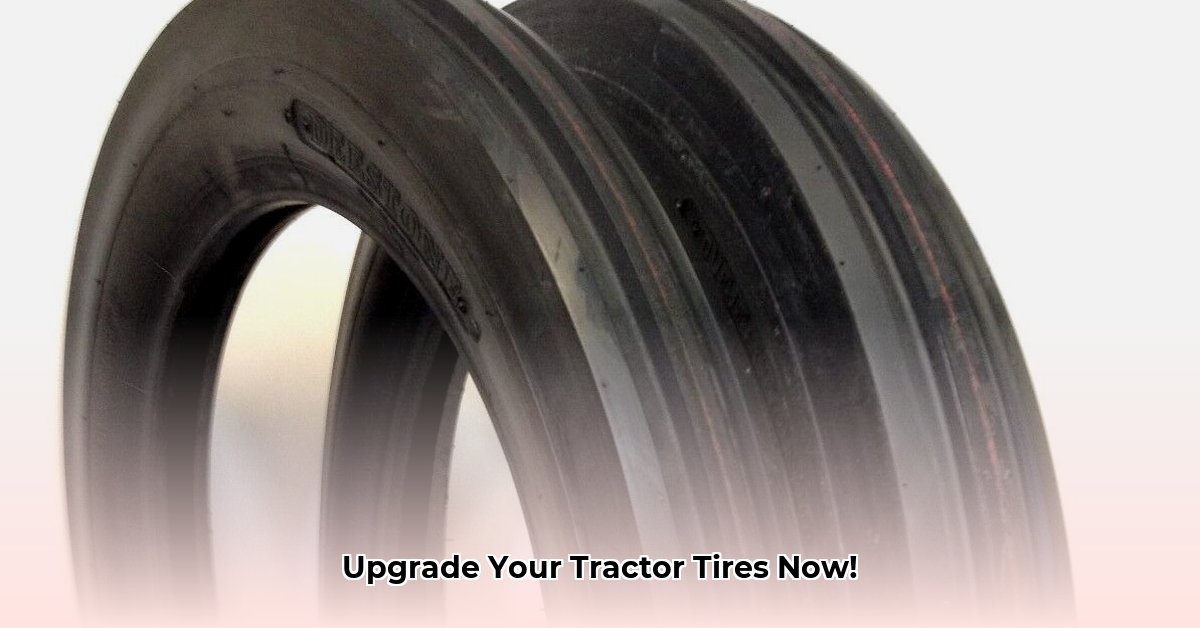
Finding the right tractor tire can be overwhelming. This guide simplifies the process, focusing on the popular 4.00-19 size commonly used on smaller tractors. We'll cover everything from understanding tire specifications to installation, maintenance, and troubleshooting. For a visual guide on tire changes, see this helpful resource.
Assessing Your Tractor and its Workload: The Foundation for Tire Selection
Before diving into tire specs, understanding your tractor's needs is paramount. This initial assessment will significantly impact your tire choice.
- Tractor Type and Size: What size and type of tractor do you operate? Compact? Larger? Knowing this helps determine the appropriate tire strength and load capacity.
- Workload Intensity: What tasks does your tractor perform? Heavy hauling? Light maintenance? The intensity impacts tire durability requirements. Heavy-duty work necessitates robust tires.
- Terrain Type: Are your fields muddy, rocky, or smooth? The terrain dictates the ideal tread pattern for optimal grip and longevity. Muddy conditions demand aggressive treads, while hard-packed surfaces might benefit from smoother patterns.
- Budget: Higher-quality tires may have higher upfront costs but frequently offer better long-term value due to increased durability, resulting in fewer replacements.
Answering these questions helps you narrow down the options and target tires that best match your specific needs.
Decoding Tire Specifications: Understanding 4.00-19 and Key Terms
The "4.00-19" designation provides crucial information about tire dimensions: 4.00 inches is the tire width, and 19 inches is the rim diameter.
Beyond size, several critical specifications influence performance and longevity:
- Ply Rating: This signifies the tire's strength and durability. Higher ply ratings indicate a stronger, more durable tire, ideal for heavy-duty applications. (Think of it as the tire's "muscle".)
- Load Capacity: This indicates the maximum weight a tire can safely carry. Exceeding this limit compromises tire integrity and safety. Always check your tractor's manual for recommended load capacities.
- Tread Pattern: The design of the tire's surface impacts traction and longevity. Aggressive patterns excel in muddy conditions, while smoother patterns provide better wear on hard surfaces. Consider R-1, R-1W, or R-3 patterns common in agricultural tires. The choice depends on your typical soil conditions.
Understanding these terms ensures you choose a tire that adequately meets the demands of your work environment.
Choosing Your 4.00-19 Tire: A Step-by-Step Guide
Selecting the perfect tire involves a structured approach:
- Consult Your Tractor Manual: This is your first resource. Manufacturers recommend specific tire specifications for optimal performance and safety.
- Assess Your Workload and Terrain: Refer back to the initial assessment of your farming operation. Match tire characteristics (ply, load capacity, tread) to your specific conditions.
- Compare Tire Specifications: Research different brands and models, comparing ply rating, load capacity, and tread patterns to ensure they align with your operation’s demands.
- Read Reviews: Utilize online reviews to gauge the real-world performance and durability of various tire options.
- Factor in Your Budget: While initial cost is a factor, evaluate long-term cost-effectiveness. A higher-quality tire might last significantly longer, saving you money in the long run.
Installation, Maintenance, and Troubleshooting Common Issues
Proper installation and regular maintenance are paramount for optimal tire performance and safety. Improper installation can cause imbalances and premature wear.
Regular Maintenance:
- Tire Pressure Checks: This is crucial! Under-inflation reduces fuel efficiency and increases wear. Over-inflation leads to a rougher ride and higher puncture risk. Always adhere to the manufacturer's recommended pressure. Regular checks are essential.
- Tire Inspections: Regularly inspect for cuts, embedded objects, and unusual wear patterns. Address these promptly to prevent more substantial damage.
Common Problems and Solutions:
| Problem | Possible Causes | Solutions |
|---|---|---|
| Punctures | Sharp objects | Repair (if minor) or tire replacement |
| Uneven Wear | Incorrect inflation, misalignment | Adjust pressure, check alignment, and avoid overloading |
| Pressure Loss | Punctures, faulty valves | Repair or replace as needed |
| * Sidewall Damage: Impacts with obstacles | Tire replacement (generally not repairable) |
Prioritizing maintenance safeguards your tractor's performance and your safety.
Finding Your 4.00-19 Tires: Resources
Many online and local retailers sell 4.00-19 tractor tires. Thoroughly research suppliers, compare prices, and read customer reviews before purchasing.
Choosing the right 4.00-19 tractor tire involves careful consideration of your specific operational needs. Prioritize tire specifications, proper maintenance, and safe installation practices for optimal performance and longevity.